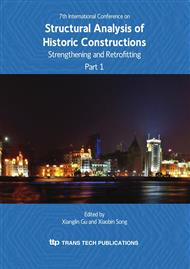p.861
p.867
p.873
p.879
p.885
p.891
p.897
p.903
p.911
The Research on the Rust of Reinforced Bar and the Strengthening Measures to the Existed R.C. Frame nearby the Sea
Abstract:
The netlike cracks along the rebars at the bottom of concrete slabs as well as the circular cracks around the columns and beams were found in an underground park, which is a cast-in-site concrete frame. The building was about 300 m away from the sea. The influencial factors which can cause rust of the rebars, such as concrete carbonization, chloride ion (Cl-1) content, and design & construction measures, were analyzed respectively. The in-site inspections and X-spectrum analysis of concrete specimens drilled from the R.C. members were conducted. The concrete carbonization depth and the concrete protection layer were also collected. In order to find out the main influence factor, steps were carried out as following: at first, according to comparison with the data of calculation and inspection results, the formula for the partial carbonization depth was modified to be used at high humidity environment. Then, the weight ratio of Cl-1 in the drilled R.C. members was 0.02%~0.07% and was lower than the required index 0.1% set by department of construction of Shandong province (DBJ14-S6-2005). The thickness of the concrete protection layer was measured and found to be thinner than the standard set by DBJ14-S6-2005, so as the main reason was identified at last. To ensure the safety and durability of the building, strengthening measures were brought forward with consideration of the results from both the theoretical calculation and the inspections. The rusted concrete protectionion layer was removed and the anti-rust reagent was brushed when the rusted rebar was cleansed by special machine which can meet the durability requirements. The carbonic fibres reinforcement polymers were stuck on the new concrete protection layer which can provided the bearing capacity. The measures can be a good reference for the same project.
Info:
Periodical:
Pages:
885-890
Citation:
Online since:
October 2010
Authors:
Keywords:
Price:
Сopyright:
© 2010 Trans Tech Publications Ltd. All Rights Reserved
Share:
Citation:


